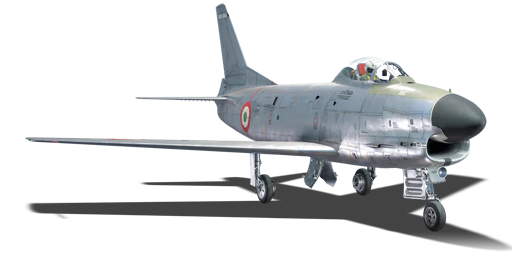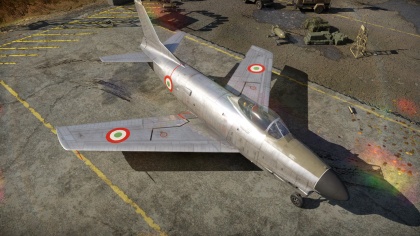Difference between revisions of "F-86K (Italy)"
(→Flight performance) (Tag: Visual edit) |
|||
| Line 1: | Line 1: | ||
| − | {{Specs-Card|code=f-86k_late_italy}} | + | {{Specs-Card |
| + | |code=f-86k_late_italy | ||
| + | |cockpit=cockpit_f-86k_late_italy.jpg | ||
| + | }} | ||
{{About | {{About | ||
| about = jet fighter '''{{PAGENAME}}''' | | about = jet fighter '''{{PAGENAME}}''' | ||
Revision as of 12:52, 29 November 2020
Contents
| This page is about the jet fighter F-86K (Italy). For other versions, see F-86 (Family). |
Description
The ▄F-86K Sabre is a rank VI Italian jet fighter
with a battle rating of 9.0 (AB/RB) and 9.3 (SB). It was introduced in Update 1.91 "Night Vision".
The original F-86D was developed as bomber interceptor and was outfitted with a retractable ventral rocket-rack which housed 24 x 2.75 in (70 mm) Mighty Mouse folding-fin aerial rockets. Lacking cannons or air-to-air missiles, the F-86D was limited in role strictly as a bomber hunter. In 1953 the Italians approached North American in an attempt to modify the existing F-86D into a fighter-interceptor, however, the proposed changes proved too costly. This cost overage required scaling back the requirements and from this was produced the F-86K, a fighter-interceptor aircraft which was outfitted with 4 x 20 mm cannons and two AIM-9B Sidewinder missiles. Originally this aircraft was produced for the U.S., however, later the Italian manufacturer Fiat was licensed to also manufacture and produce this version of the fighter.
|
Fun Fact: The Sabre Dog was initially to be designated F-95, but had its name changed to F-86D instead, in order to make it seem like a variant of the existing Sabre and not an entirely new aircraft. In reality, however, the F-86D was only about 25% similar to the original F-86 and the name change was only done to secure further support for the project.
|
General info
Flight performance
The F-86K is a good aircraft at its rank, but not the best. The F-86K has very good low-end acceleration due to its afterburner, however, this aircraft is still only a subsonic fighter. Like every other jet, it's bad at manoeuvring at low speeds and it's control surfaces compress at high speeds. However, the F-86K can handle top speed relatively well compared to other aircraft of its rank. If the F-86K can do one thing very well, it excels when going into vertical flight.
| Characteristics | Max Speed (km/h at 0 m - sea level) |
Max altitude (metres) |
Turn time (seconds) |
Rate of climb (metres/second) |
Take-off run (metres) | |||
|---|---|---|---|---|---|---|---|---|
| AB | RB | AB | RB | AB | RB | |||
| Stock | 1,103 | 1,097 | 15500 | 27.4 | 28.3 | 42.7 | 37.1 | 1,000 |
| Upgraded | 1,121 | 1,111 | 26.6 | 27.0 | 73.1 | 56.0 | ||
Details
| Features | |||||
|---|---|---|---|---|---|
| Combat flaps | Take-off flaps | Landing flaps | Air brakes | Arrestor gear | Drogue chute |
| ✓ | ✓ | ✓ | ✓ | X | ✓ |
| Limits | ||||||
|---|---|---|---|---|---|---|
| Wings (km/h) | Gear (km/h) | Flaps (km/h) | Max Static G | |||
| Combat | Take-off | Landing | + | - | ||
| 0 | 350 | 620 | 620 | 370 | ~8 | ~4 |
| Optimal velocities (km/h) | |||
|---|---|---|---|
| Ailerons | Rudder | Elevators | Radiator |
| < 850 | < 600 | < 660 | N/A |
Engine performance
| Engine | Aircraft mass | ||||||
|---|---|---|---|---|---|---|---|
| Engine name | Number | Empty mass | Wing loading (full fuel) | ||||
| General Electric J47-GE-17B | 1 | 6,430 kg | 292 kg/m2 | ||||
| Engine characteristics | Mass with fuel (no weapons load) | Max Takeoff Weight | |||||
| Weight (each) | Type | 13m fuel | 20m fuel | 30m fuel | 46m fuel | ||
| 1,150 kg | Afterburning axial-flow turbojet | 6,952 kg | 7,227 kg | 7,620 kg | 8,248 kg | 9,530 kg | |
| Maximum engine thrust @ 0 m (RB / SB) | Thrust to weight ratio @ 0 m (100%) | ||||||
| Condition | 100% | WEP | 13m fuel | 20m fuel | 30m fuel | 46m fuel | MTOW |
| Stationary | 2,294 kgf | 4,467 kgf | 0.64 | 0.62 | 0.59 | 0.54 | 0.47 |
| Optimal | 2,294 kgf (0 km/h) |
4,467 kgf (0 km/h) |
0.64 | 0.62 | 0.59 | 0.54 | 0.47 |
Survivability and armour
The plane is equipped at the front with a 6.35 mm steel plate protecting the pilot's wrist and up. The cockpit's frontal glass is made of 38mm of bulletproof glass that helps against incoming small caliber rounds. All the while the pilot's seat is made of 12.7mm of steel which protects his back of any incoming small caliber rounds and shrapnel.
Radars
The F-86K is equipped with an AN/APS-21 search radar, located in the nose of the aircraft.
| AN/APS-21 - Target Detection Radar | |||
|---|---|---|---|
| Maximum Detection Range |
Guaranteed Detection Range |
Max Azimuth Scan Angle |
Max Elevation Scan Angle |
| 45,000 m | 28,000 m | ±85° | ±16° |
Armaments
Offensive armament
The F-86K (Italy) is armed with:
- 4 x 20 mm M24A1 cannons, nose-mounted (132 rpg = 528 total)
Suspended armament
The F-86K (Italy) can be outfitted with the following ordnance:
- Without load
- 2 x AIM-9B Sidewinder missiles
Usage in battles
The F-86K should be used mainly as a support fighter, due to its sub-par manoeuvrability at low speeds compared to other aircraft at its rank such as the MiG-17. In a 1 vs 1 dogfight, the F-86K is outclassed when pitted against a MiG-17 unless you fight in the vertical. When it comes to bomber hunting, this aircraft has four 20 mm M24A1 cannons which is more than enough, but you will sadly almost never see a bomber. These are also fantastic to use during a head-on attack, but don't commit to head-ons. Instead, fire a burst from maybe .8 km out then pull out. This is to decrease the chances of both of you crashing. Your opponents will mainly be other similarly tiered aircraft, such as the F-86F-2 and J32B.
The 2 x AIM-9Bs are perfect for the rare chance you see a bomber, or if someone is trying to run away from you. However, these should never be used against a plane that is actively turning due to the poor tracking rate.
Modules
| Tier | Flight performance | Survivability | Weaponry | ||
|---|---|---|---|---|---|
| I | Fuselage repair | Compressor | Offensive 20 mm | ||
| II | New boosters | Airframe | AIM-9B | ||
| III | Wings repair | Engine | New 20 mm cannons | ||
| IV | G-suit | Cover | |||
Pros and cons
Pros:
- Good top speed
- Good roll rate at low/medium speed (<800 km/h)
- Good acceleration with afterburner
- Has a search radar (can only spot bombers or large attackers)
- High velocity 20 mm cannons, highly effective in head-ons and deflection shots
- Possesses payload of two AIM-9B Sidewinder air-to-air missiles
- Brake chute
Cons:
- Subsonic
- Heavy compared to regular Sabres so less nimble, even with leading slats
- Hard compression at high speed (>900 km/h), especially in the roll axis
- Can easily rip wings with strong input
- Afterburner guzzles a lot of fuel
- Missile lock can be broken with a high-G manoeuvre
- No bombs or rockets
History
The F-86K is the NATO variant of the F-86D with the exception it did not sport the internal FFAR Mighty Mouse rocket launcher, but 20 mm cannons and Sidewinder missiles instead. Many foreign countries wanted a high altitude interceptor. This need was created by the Soviet bomber threat many Western countries feared of. The U.S. felt the F-86D would be the perfect candidate for NATO countries, however, they didn't give the F-86D away. This was due to sensitive material the F-86D possessed, especially the state-of-the-art fire control system. Not only was the fire control system sensitive info, but it was also unreliable and the U.S. did not want to give unreliable equipment to other NATO countries. So the U.S. came up with the F-86K, an almost exact copy of the F-86D other than an improvised fire control and a slightly longer nose. After the F-86K was designed, production started with NAA (North American Arms) making around a hundred F-86K's. These were shipped to NATO countries and Italy, but the U.S. also sent sets of parts to Italy around 1956. Fiat took these sets and assembled their own F-86K's. Some of the Fiat assembled F-86K's were shipped to France or other NATO countries. Italy continued to use F-86K's up until they started to slowly get rid of them starting 1964 to make space for the F-104 Starfighter. The last Italian F-86K was decommissioned in 1973.
Media
- Videos
See also
- Related development
- Canadair Sabre (those Sabres manufactured with the designator "CL")
- North American F-86A/F
- North American F-100 Super Sabre
- North American FJ-4 Fury
- Aircraft of comparable role, configuration and era
- Dassault Super Mystère
- Grumman F-9 Cougar
- Hawker Hunter
- Lavochkin La-15
- Mikoyan-Gurevich MiG-15
- Mikoyan-Gurevich MiG-17
- Saab J29 Tunnan
External links
| Fiat Aviation (Fiat Aviazione) | |
|---|---|
| Fighters | CR.32 · CR.32 bis · CR.32 quater |
| CR.42 · Marcolin's C.R.42 CN · ▀Marcolin's C.R.42 CN | |
| G.50 serie 2 · G.50 AS serie 7 | |
| G.55 sottoserie 0 · G.55 serie 1 · G.55S | |
| G.56 | |
| Jet fighters | G.91 pre-serie · G.91 R/1 · G.91 Y · G.91 YS |
| ▄F-86K* | |
| ▄F-104G* · F-104S* · F-104S.ASA* · ▄F-104S TAF* | |
| Strike aircraft | F.C.20 Bis |
| Bombers | B.R.20DR · B.R.20M M1 |
| Export/Captured | J11 · ▀CR.42 |
| ▀G.50 serie 2 · ▀G.50 AS serie 7 | |
| ◄G.91 R/3 · ◄G.91 R/4 · G.91 R/4 | |
| *Licensed | |
| See also | North American Aviation · Lockheed Martin |
| Italy jet aircraft | |
|---|---|
| Aerfer | Sagittario 2 · Ariete |
| Fiat | G.91 pre-serie · G.91 R/1 · G.91 R/4 (Portugal) · G.91 Y · G.91 YS |
| AMX International | AMX · AMX A-1A (Brazil) |
| Panavia | Tornado ADV · ▄Tornado IDS · ▄Tornado IDS (1995) |
| Foreign: | |
| Vampire | Vampire FB 52A |
| F-84 | ▄F-84F · ▄F-84G-21-RE |
| F-86 | CL-13 Mk.4 · ▄F-86K |
| F-104 | ▄F-104G · F-104S · ▄F-104S TAF (Turkey) · F-104S.ASA |
| F-16 | ▄F-16A ADF |
| AV-8 | ▄AV-8B Plus |
| Hungary | |
| Mikoyan-Gurevich | ◔MiG-15bis · ◔MiG-17PF · ◔MiG-21MF · ◔MiG-21bis-SAU · ◔MiG-23MF · ◔MiG-29 |
| Ilyushin | ◔IL-28 |
| Sukhoi | ◔Su-22M3 |
| Saab | ◔JAS39EBS HU C |





